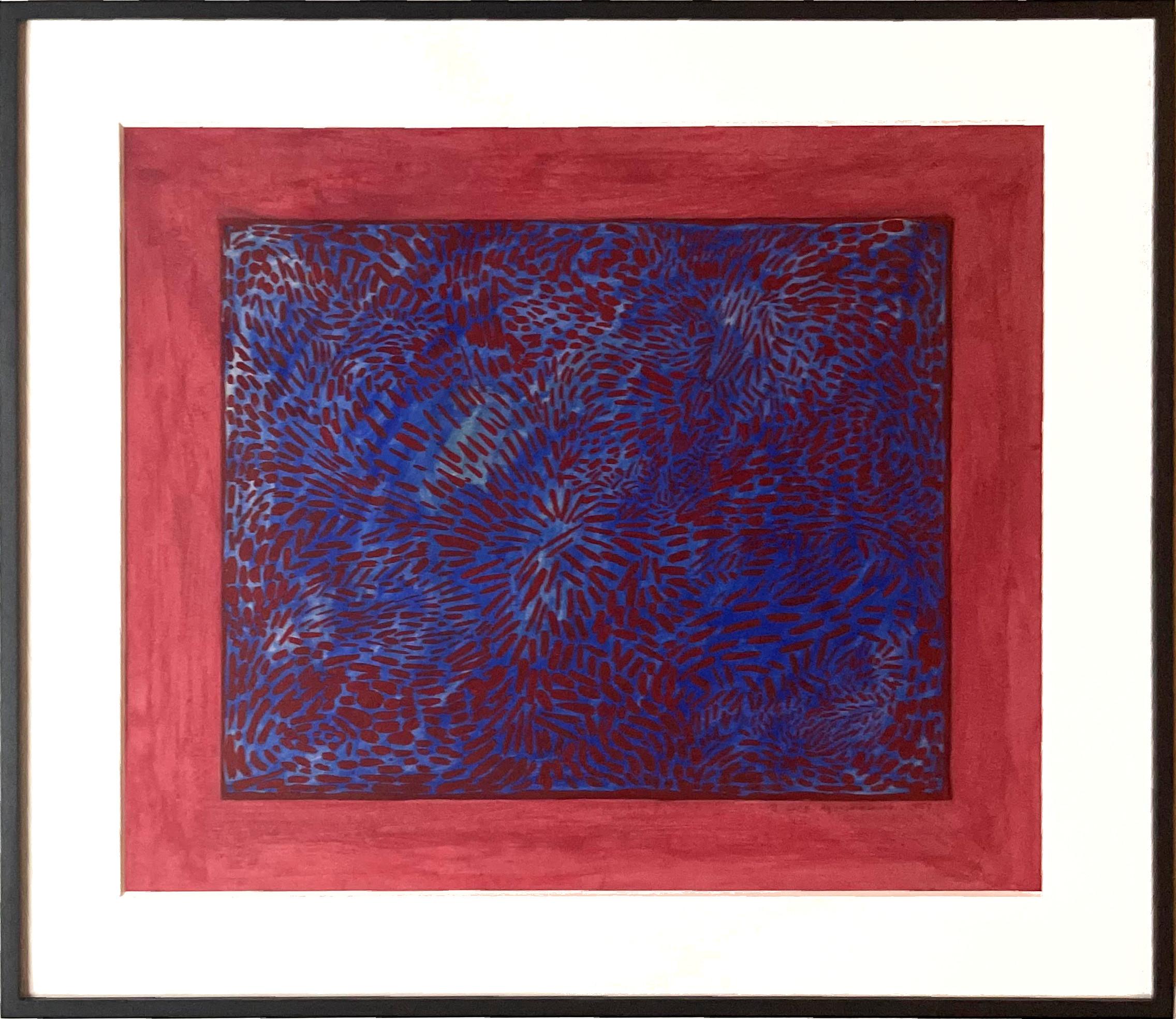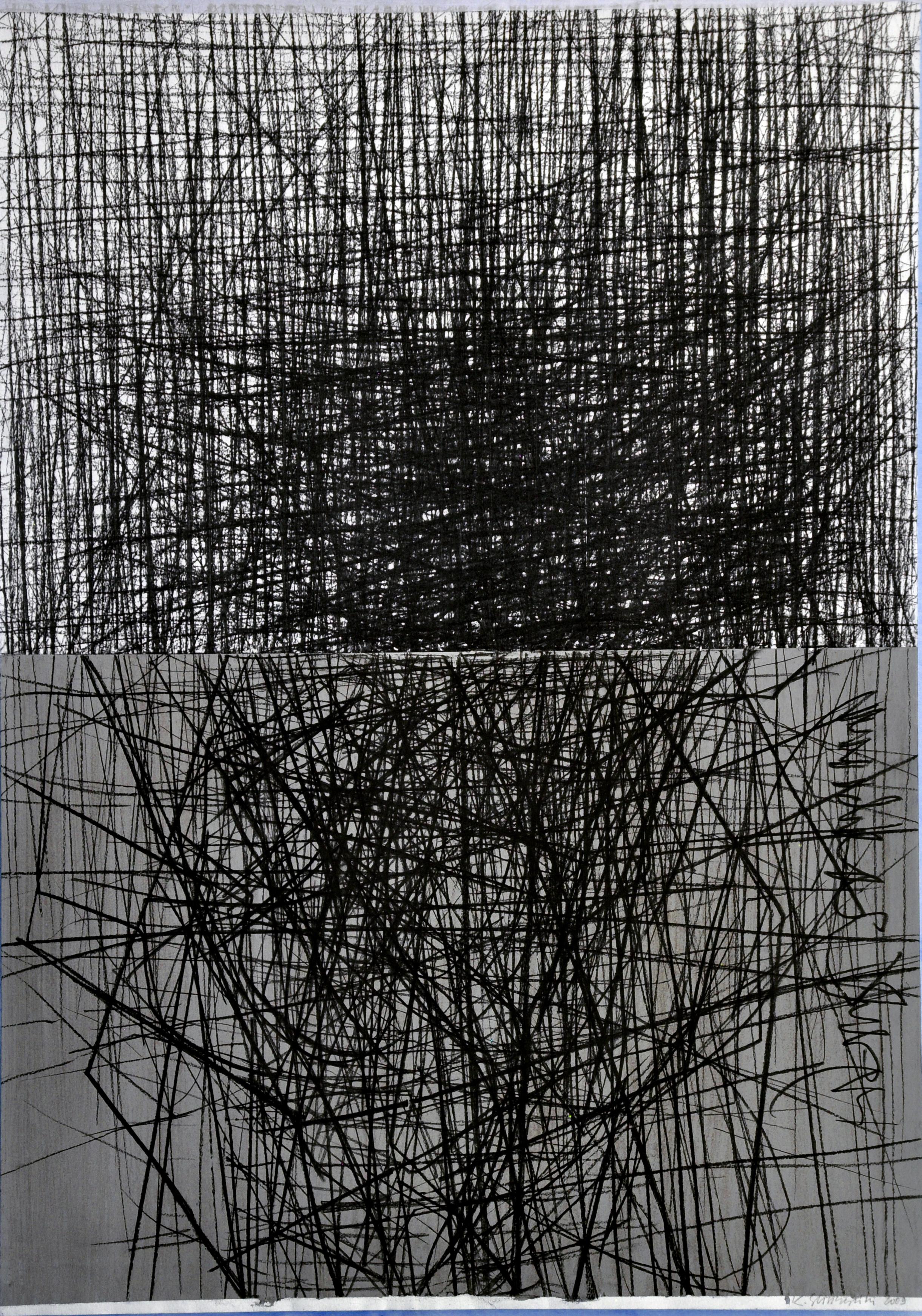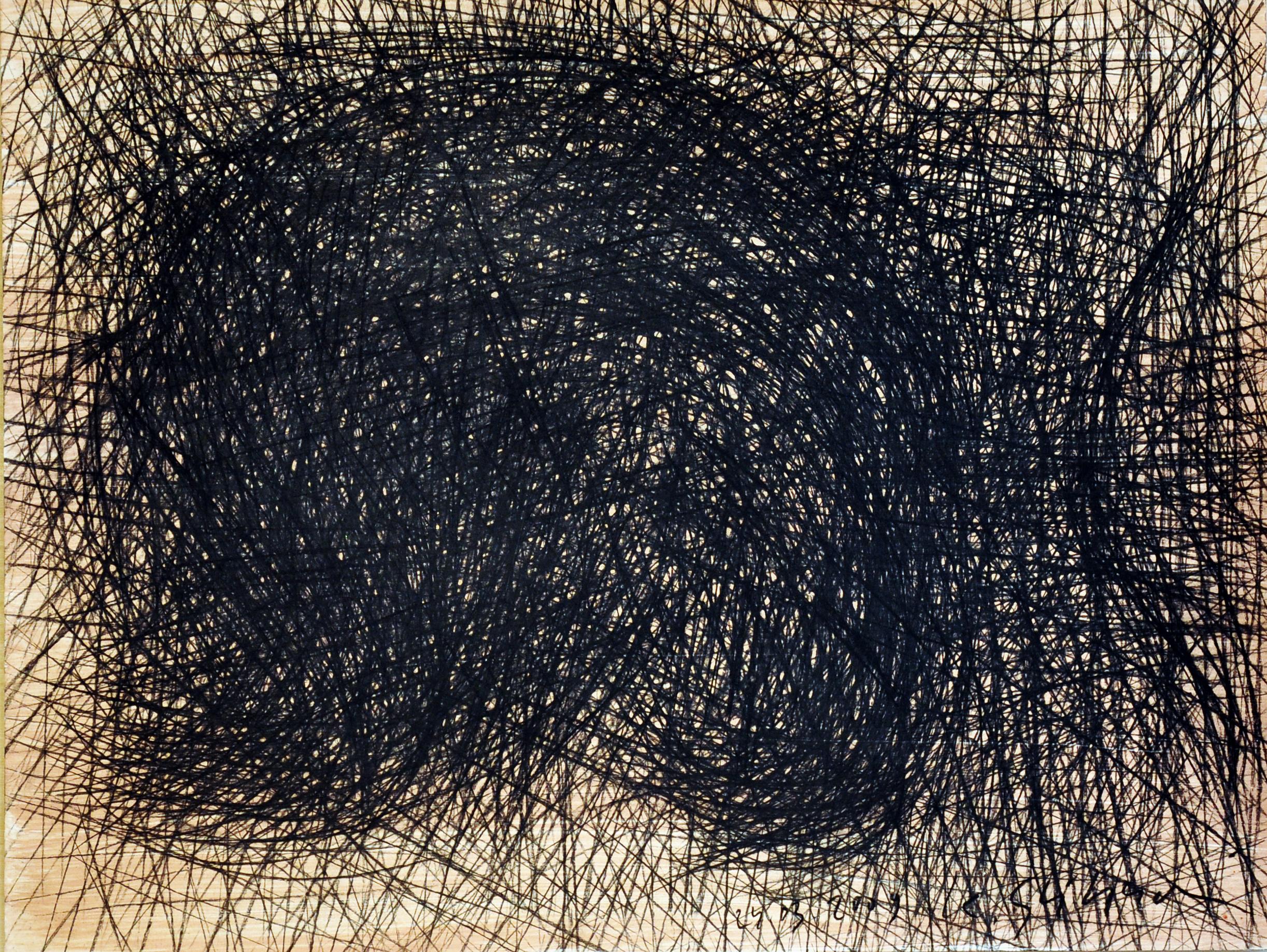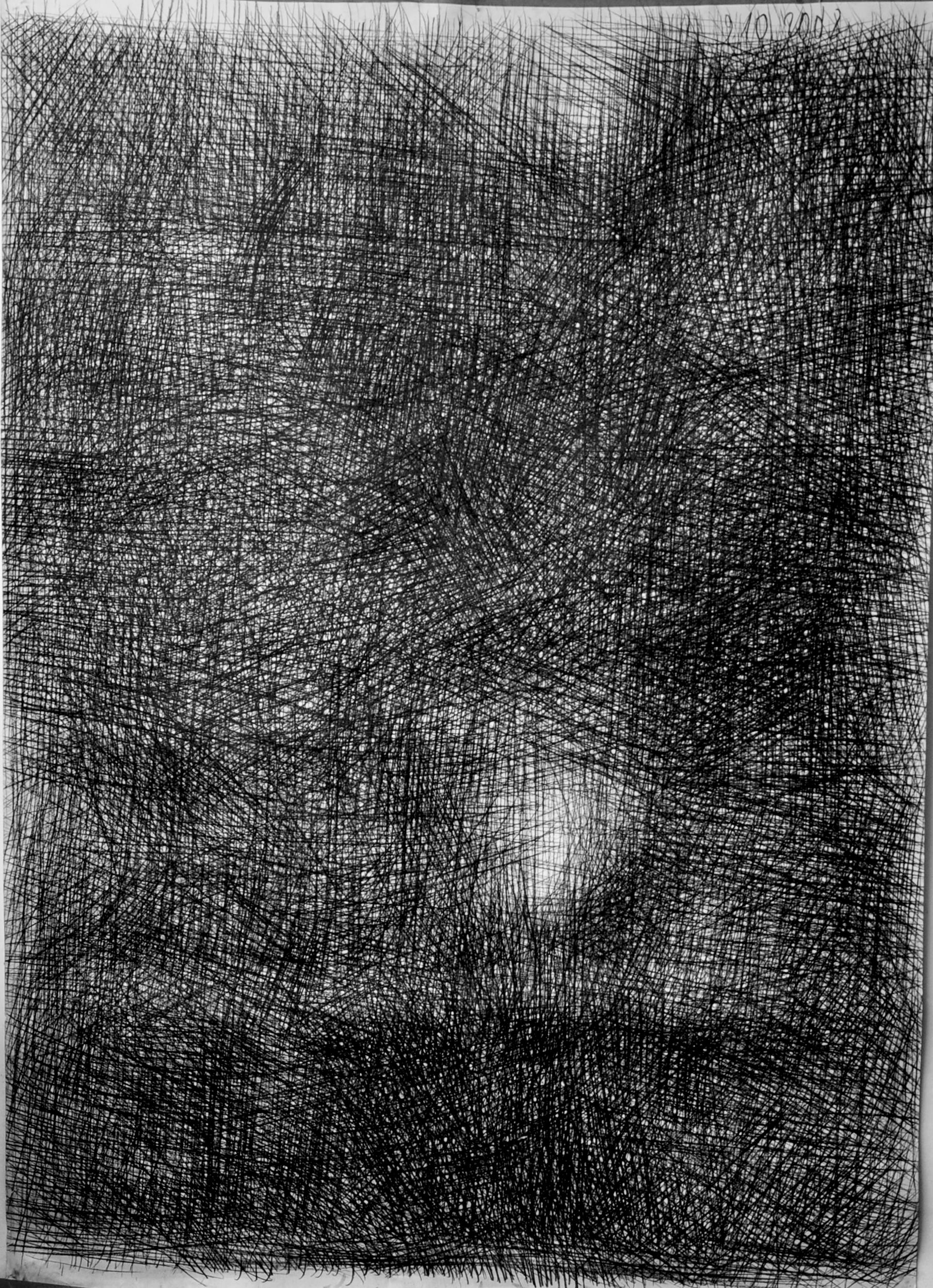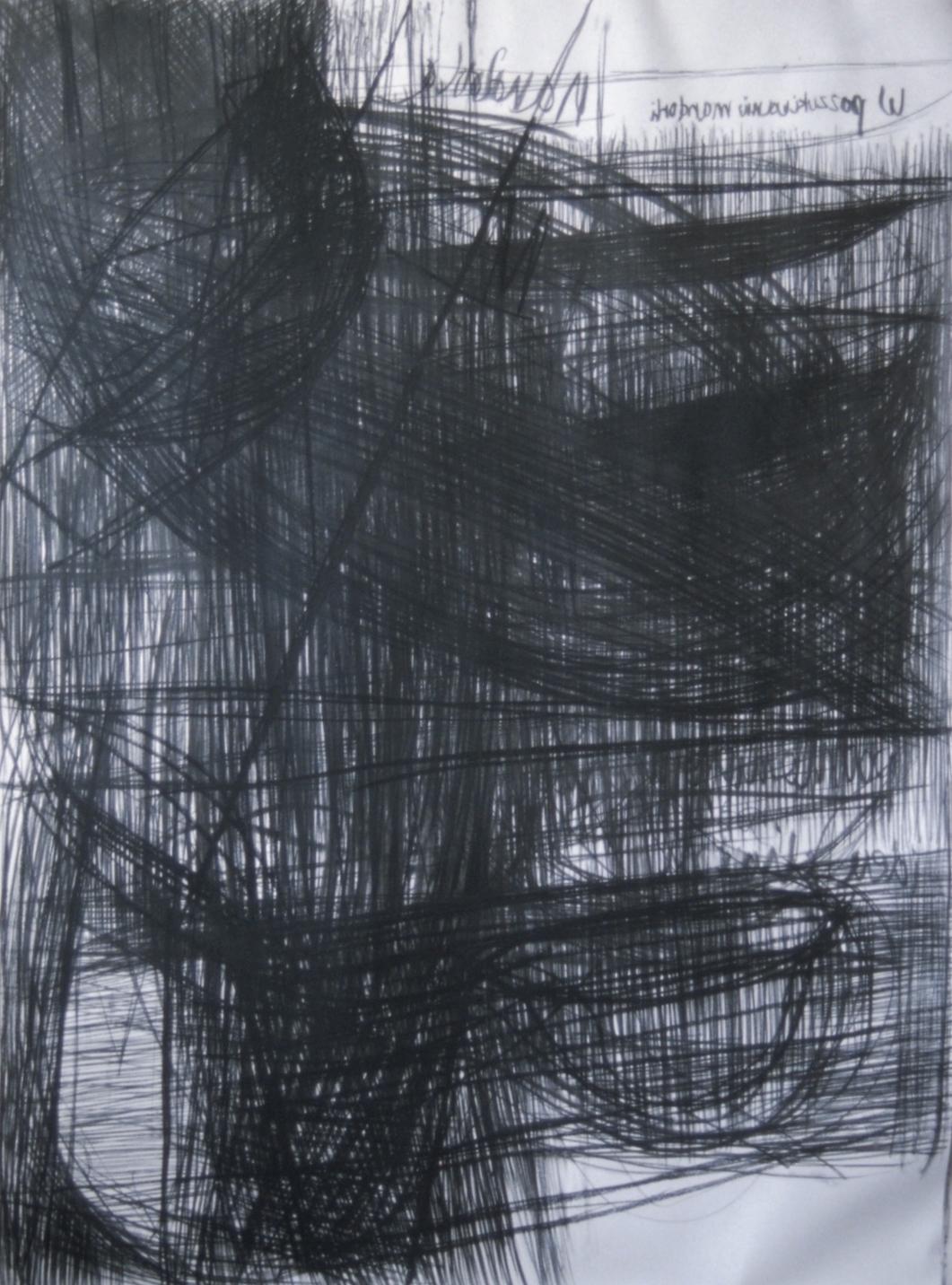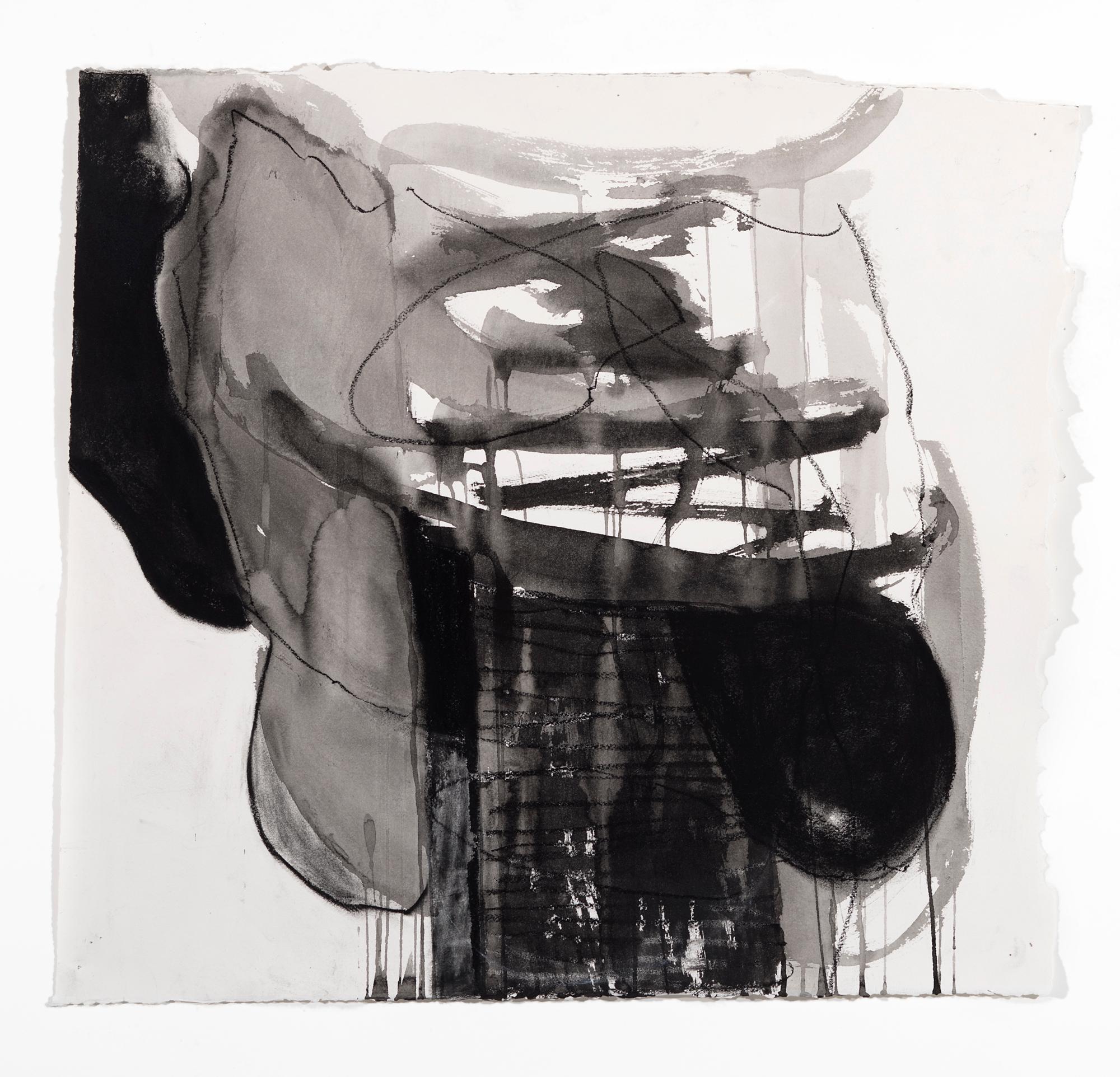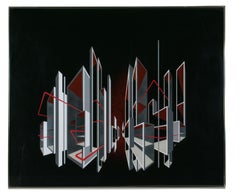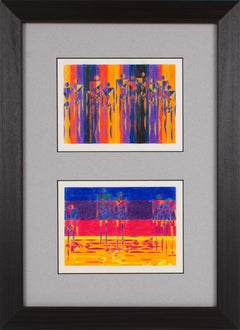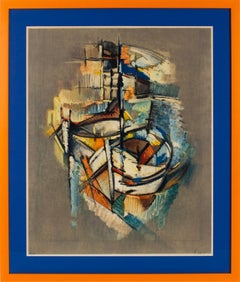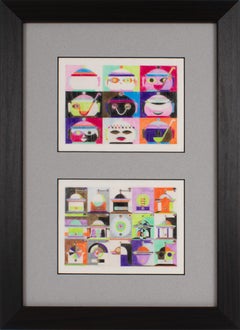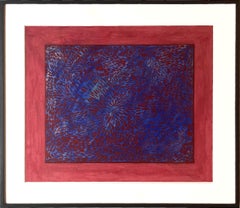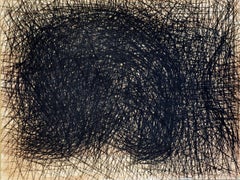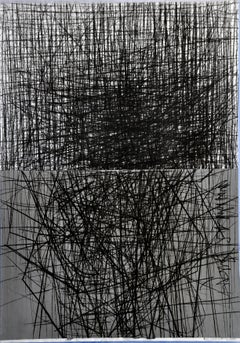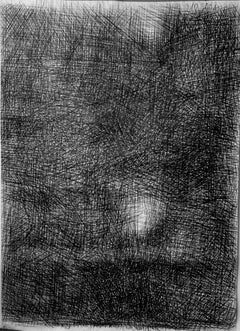Items Similar to Brutalist Op Art Abstract Charcoal Drawing by Dordevic Miodrag
Want more images or videos?
Request additional images or videos from the seller
1 of 15
Dordevic MiodragBrutalist Op Art Abstract Charcoal Drawing by Dordevic Miodragcirca 1960
circa 1960
About the Item
Serbian artist Dordevic (or Djordjevic) Miodrag (1936 -), known as "Miodrag," designed this stunning abstract drawing. This work is a charcoal on paper depicting a brutalist abstract form with geometric influence. The contrasted execution adds considerable energy and presence to the design with a minimalist interpretation. The artist's signature is in the top right corner. The artwork is still in its original vintage wood frame with dark red liner and acrylic glass protection.
Despite small cracks in the back protection paper, the artwork is in good condition. Please note some light wrinkles on the drawing. The wood framing shows some wear.
Measurements:
With frame: 20 in wide (51 cm) x 24.75 in high (63 cm).
Opening view: 11.82 in wide (30 cm) x 16.13 in high (41 cm).
About:
Miodrag Djordjevic known as "MIODRAG" was born in 1936 in Aleksinac, Serbia.
Miodrag is not an easy artist to describe.
Wherever he goes, Miodrag arouses passion and interest, whether in Italy, the United States, Belgium, or France where he has had numerous exhibitions. The collections of Giulio Andreotti, Sophia Loren, Nathalie Wood, and Henry Miller carried several of Miodrag's pieces.
The style of Miodrag's artwork reflects the various stages of his creative life. Whether working with oil, pastel, charcoal, or silkscreen, this artist is a master of all mediums. Famous galleries in Rome, Florence, Dallas, Miami, Paris, and Brussels have promoted his talent.
He is one of the founding pillars of Op Art or Optical Art, with sublime combinations of geometric shapes, shadows, light, and virtual movement.
More recently, his work brought him to lyrical Surrealism, to which he made an unavoidable contribution.
Highly influenced by scientific advances, climate deregulation, and natural disasters, his recent art pieces are an ode to the beauty of nature and its secrets, an incentive for reflection, dreams, and the spiritual.
By the extent of his work and the diversity of his styles, Miodrag stands as an atypical artist, a precursor to unique talent, and the absolute value of contemporary art.
- Creator:Dordevic Miodrag (1936, Serbian)
- Creation Year:circa 1960
- Dimensions:Height: 24.75 in (62.87 cm)Width: 20 in (50.8 cm)Depth: 2.38 in (6.05 cm)
- Medium:
- Movement & Style:
- Period:
- Condition:
- Gallery Location:Atlanta, GA
- Reference Number:Seller: 5Q0731stDibs: LU1212212605502
About the Seller
5.0
Vetted Professional Seller
Every seller passes strict standards for authenticity and reliability
1stDibs seller since 2019
76 sales on 1stDibs
- ShippingRetrieving quote...Shipping from: Atlanta, GA
- Return Policy
Authenticity Guarantee
In the unlikely event there’s an issue with an item’s authenticity, contact us within 1 year for a full refund. DetailsMoney-Back Guarantee
If your item is not as described, is damaged in transit, or does not arrive, contact us within 7 days for a full refund. Details24-Hour Cancellation
You have a 24-hour grace period in which to reconsider your purchase, with no questions asked.Vetted Professional Sellers
Our world-class sellers must adhere to strict standards for service and quality, maintaining the integrity of our listings.Price-Match Guarantee
If you find that a seller listed the same item for a lower price elsewhere, we’ll match it.Trusted Global Delivery
Our best-in-class carrier network provides specialized shipping options worldwide, including custom delivery.More From This Seller
View AllCityscape Kinetic Optical Op Art Painting on Plexiglass by L.L. Long
Located in Atlanta, GA
American artist L. L. Long created this striking composition in 1980. The artwork features a kinetic optical Op Art geometric cityscape design using reverse spray paint on a Lucite o...
Category
1980s Op Art Abstract Paintings
Materials
Lucite, Plexiglass, Spray Paint
Geometric Colorist Project Surrealist Drawings on Tracing Paper, France 1960s
Located in Atlanta, GA
Stunning, rare original project drawings, hand-painted with colored pencil on translucent tracing paper by a French artist, circa the 1960s. The two paintings feature a geometric stu...
Category
1960s Modern Abstract Drawings and Watercolors
Materials
Paper, Color Pencil
Abstract Cubist Seascape Lithograph by Roger Lersy
By Roger Lersy
Located in Atlanta, GA
Lithograph on paper by Roger Lersy (France, 1920 - 2004). This stunning abstract seascape cubist composition has a highly colorful design of old boats executed by the artist in Franc...
Category
1950s Cubist Landscape Prints
Materials
Lithograph
Geometric Multicolor Surrealist Drawings on Tracing Paper, France 1960s
Located in Atlanta, GA
These lovely original project drawings, hand-painted with colored pencils on translucent tracing paper, were designed by a French artist circa the 1960s. The two paintings feature a study of kitchen accessories: a soup tureen and a vintage coffee bean...
Category
1960s Surrealist Abstract Drawings and Watercolors
Materials
Paper, Color Pencil
Surrealist Geometric Colorist Project Drawings on Tracing Paper, circa 1960
Located in Atlanta, GA
Stunning original project drawings, hand-painted with colored pencil on translucent tracing paper by a French artist, circa 1960. The two paintings feature a geometric study in color...
Category
1960s Modern Abstract Drawings and Watercolors
Materials
Paper, Color Pencil
Geometric Color Variation Surrealist Drawings on Tracing Paper, France 1960s
Located in Atlanta, GA
These stunning original project drawings, hand-painted with colored pencils on translucent tracing paper, were designed by a French artist circa the 1960s. The two paintings feature ...
Category
1960s Surrealist Abstract Drawings and Watercolors
Materials
Paper, Color Pencil
You May Also Like
Near and Far Acuity, Signed Mid Century Modern Op Art painting, historic exhibit
By Richard Anuszkiewicz
Located in New York, NY
Richard Anuszkiewicz
Near and Far Acuity, 1957
Gouache and watercolor painting
Hand signed and dated 1957 by Richard Anuszkiewicz on the right front
Frame included
Anuszkiewicz' artw...
Category
Mid-20th Century Op Art Abstract Drawings and Watercolors
Materials
Mixed Media, Watercolor, Gouache
Untitled 1 - Expressive Charcoal On Paper Painting, Black White Drawing
By Krzysztof Gliszczyński
Located in Salzburg, AT
The paper of the work is not yellowed, there is a applied yellowed primer under the drawing
Krzysztof Gliszczyński is Professor for painting o...
Category
Early 2000s Conceptual Abstract Drawings and Watercolors
Materials
Paper, Charcoal
TWO SPACES - Expressive Charcoal On Paper Painting, Black White Drawing
By Krzysztof Gliszczyński
Located in Salzburg, AT
The work is on 1 paper.
Krzysztof Gliszczyński is Professor for painting on Academy of fine arts Gdansk.
The artwork is unframed and will be...
Category
Early 2000s Conceptual Abstract Drawings and Watercolors
Materials
Paper, Charcoal
Light, Series Drawing From Israel - Large Format, Charcoal On Paper
By Krzysztof Gliszczyński
Located in Salzburg, AT
The artwork is unframed and will be shipped rolled in a tube
Krzysztof Gliszczyński is Professor for painting on Academy of fine arts Gdansk.
Krzysztof Gliszczyński born in Miastko in 1962. Graduated from the Gdańsk Academy of Fine Arts in 1987 in the studio of Prof. Kazimierz Ostrowski. Between 1995 and 2002 founder and co-manager of Koło Gallery in Gdańsk. lnitiator of the Kazimierz Ostrowski Award, con-ferred by the Union of Polish Artists and Designers (ZPAP), Gdańsk Chapter. Dean of the Painting Faculty of the Gdańsk Academy of Fine Arts in the years 2008-2012. Vice Rector for Development and Cooperation of the Gdańsk Academy of Fine Arts in the years 2012-2016. Obtained a professorship in 2011. Currently head of the Third Painting Studio of the Painting Faculty of the Gdańsk Academy of Fine Arts. He has taken part in a few dozen exhibitions in Poland and abroad. He has received countless prizes and awards for his artistic work. He is active in the field of painting, drawing, objects, and video.
Artist Statement
In the 1990s I started collecting flakes of paint – leftovers from my work. I would put fresh ones in wooden formworks, dried ones in glass containers. They constituted layers of investigations into the field of painting, enclosed in dated and numbered cuboids measuring 47 × 10.5 × 10.5 cm. I called those objects Urns. In 2016, I displayed them at an exhibition, moulding a single object out of all the Urns. The Urns inspired me to redefine the status of my work as a painter. In order to do it, I performed a daunting task of placing the layers of paint not in an urn, but on a canvas, pressing each fresh bit of paint with my thumb. In the cycle of paintings Autoportret a’retour, the matter was transferred from painting to painting, expanding the area of each consecutive one. Together, the bits, the residua of paint, kept alive the memory of the previous works. It was a stage of the atomization of the painting matter and its alienation from the traditional concepts and aesthetic relations. Thus, the cycle of synergic paintings was created, as I called them, guided by the feeling evoked in me by the mutually intensifying flakes of paint. The final aesthetic result of the refining of the digested matter was a consequence of the automatism of the process of layering, thumb-pressing, and scraping off again. Just like in an archaeological excavation, attempts are made to unite and retrieve that which has been lost. This avant-garde concept consists in transferring into the area of painting of matter, virtually degraded and not belonging to the realm of art. And yet the matter re-enters it, acquiring a new meaning. The matter I created, building up like lava, became my new technique. I called it perpetuum pictura – self-perpetuated painting. Alchemical concepts allowed me to identify the process inherent in the emerging matter, to give it direction and meaning. In a way, I created matter which was introducing me into the pre-symbolic world – a world before form, unnamed. From this painterly magma, ideas sprung up, old theories of colour and the convoluted problem of squaring the circle manifested themselves again. Just like Harriot’s crystal refracted light in 1605, I tried to break up colour in the painting Iosis. Paintings were becoming symptoms, like in the work Pulp fiction, which at that time was a gesture of total fragmentation of matter and of transcending its boundaries, my dialogue with the works of Jackson Pollock and the freedom brought by his art. The painting Geometrica de physiologiam pictura contains a diagram in which I enter four colours that constitute an introduction to protopsychology, alchemical transmutation, and the ancient theory of colour. It this work I managed to present the identification of the essence of human physiology with art. But the essential aspect of my considerations in my most recent paintings is the analysis of abstraction, the study of its significance for the contemporary language of art and the search for the possibilities of creating a new message. For me, abstraction is not an end in itself, catering to the largely predicable expectations of the viewers. To study the boundary between visibility and invisibility, like in the work Unsichtbar, is to ask about the status of the possibilities of the language of abstraction. The moment of fluidity which I am able to attain results from the matter – matter...
Category
Early 2000s Conceptual Abstract Drawings and Watercolors
Materials
Paper, Charcoal
Mandorla - Large Format Charcoal On Paper, Black White Drawing
By Krzysztof Gliszczyński
Located in Salzburg, AT
Krzysztof Gliszczyński is Professor for painting on Academy of fine arts Gdansk.
The artwork is unframed and will be shipped rolled in a tube
Artist Statement
In the 1990s I started collecting flakes of paint – leftovers from my work. I would put fresh ones in wooden formworks, dried ones in glass containers. They constituted layers of investigations into the field of painting, enclosed in dated and numbered cuboids measuring 47 × 10.5 × 10.5 cm. I called those objects Urns. In 2016, I displayed them at an exhibition, moulding a single object out of all the Urns. The Urns inspired me to redefine the status of my work as a painter. In order to do it, I performed a daunting task of placing the layers of paint not in an urn, but on a canvas, pressing each fresh bit of paint with my thumb. In the cycle of paintings Autoportret a’retour, the matter was transferred from painting to painting, expanding the area of each consecutive one. Together, the bits, the residua of paint, kept alive the memory of the previous works. It was a stage of the atomization of the painting matter and its alienation from the traditional concepts and aesthetic relations. Thus, the cycle of synergic paintings was created, as I called them, guided by the feeling evoked in me by the mutually intensifying flakes of paint. The final aesthetic result of the refining of the digested matter was a consequence of the automatism of the process of layering, thumb-pressing, and scraping off again. Just like in an archaeological excavation, attempts are made to unite and retrieve that which has been lost. This avant-garde concept consists in transferring into the area of painting of matter, virtually degraded and not belonging to the realm of art. And yet the matter re-enters it, acquiring a new meaning. The matter I created, building up like lava, became my new technique. I called it perpetuum pictura – self-perpetuated painting. Alchemical concepts allowed me to identify the process inherent in the emerging matter, to give it direction and meaning. In a way, I created matter which was introducing me into the pre-symbolic world – a world before form, unnamed. From this painterly magma, ideas sprung up, old theories of colour and the convoluted problem of squaring the circle manifested themselves again. Just like Harriot’s crystal refracted light in 1605, I tried to break up colour in the painting Iosis. Paintings were becoming symptoms, like in the work Pulp fiction, which at that time was a gesture of total fragmentation of matter and of transcending its boundaries, my dialogue with the works of Jackson Pollock and the freedom brought by his art. The painting Geometrica de physiologiam pictura contains a diagram in which I enter four colours that constitute an introduction to protopsychology, alchemical transmutation, and the ancient theory of colour. It this work I managed to present the identification of the essence of human physiology with art. But the essential aspect of my considerations in my most recent paintings is the analysis of abstraction, the study of its significance for the contemporary language of art and the search for the possibilities of creating a new message. For me, abstraction is not an end in itself, catering to the largely predicable expectations of the viewers. To study the boundary between visibility and invisibility, like in the work Unsichtbar, is to ask about the status of the possibilities of the language of abstraction. The moment of fluidity which I am able to attain results from the matter – matter...
Category
Early 2000s Conceptual Abstract Drawings and Watercolors
Materials
Paper, Charcoal
Untitled (Georgia III)
By Anastasia Pelias
Located in New Orleans, LA
ANASTASIA PELIAS was born in New Orleans, LA to Greek parents. Her artistic practice is rooted in the dual cultural identity of both her native and ancestral roots in New Orleans, LA...
Category
2010s Contemporary Abstract Paintings
Materials
Paper, Charcoal, Ink, Mixed Media
Recently Viewed
View AllMore Ways To Browse
Framed Drawings
Charcoal Framed Art
Charcoal Drawing Paris
Brutalist Wood Art
Italian Charcoal Drawing
Brutalist Art Glass
Serbian Art
Italian Op Art
Brutalist Art Frame
Miller High Life
Oil Painting Serbia
Brutalist Oil Painting
Vintage Sophia Loren
Sophia Loren Glasses
Miodrag Dordevic
Ballerina and Ballet Photography
A Woman Is A Woman
Sold Art
